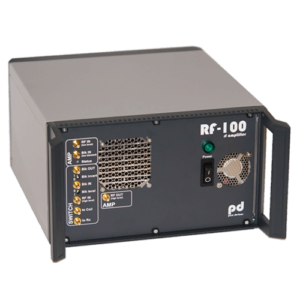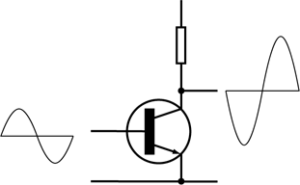What is an amplifier?
An amplifier is a device used to increase an input signal’s voltage, current, or power.
A weak electrical signal is taken in and converted into a stronger output signal. External power is used to cause this change.
There are three main classifications of amplifiers depending on the changes it makes to the input signal: voltage, current, or power amplifier.
Power Amplifier
Power amplifiers are used to increase the power level of a signal. A low-power signal is converted to a higher-power signal to drive output devices
The most common example is an audio amplifier, which drives headphones and loudspeakers.
The position of a power amplifier is usually at the end of the chain of amplifiers and other devices, as it is designed to drive output devices directly.

Audio Amplifier Block Diagram
The power amplifier requires the input signal to be at a certain magnitude (signals from the microphone aren’t strong enough for the power amplifier in this case).
Therefore, voltage or current amplifiers are used to pre-amplify the raw audio signals from the input device by increasing voltage or current.
After modifications are made by the pre-amplifiers, the signal is sent through the volume control block which makes adjustments to the audio signal
Lastly, the signal is sent as input through the power amplifier which is sent as output to the speaker.
This output power is AC, whereas the power fed to the amplifier is DC.
Therefore, it can be said that a power amplifier works by converting DC power to AC power.
Power Amplifier Types
Power amplifiers are divided into three types:
1) Audio Power Amplifiers
 These are used to increase the power of a weak audio signal.
These are used to increase the power of a weak audio signal.
These amplifiers are used commonly in speakers, televisions, mobile phones, etc.
An audio power amplifier can produce anywhere from a few milliwatts (such as in headphone amplifiers) to hundreds of watts (such as in Hi-Fi/Home theater systems).
2) Direct-Coupled (DC) Power Amplifiers
DC power amplifiers amplify the power of PWM (Pulse-Width Modulated) signals.
Electronic control systems, which require high power signals in order to drive actuators or motors, use DC power amplifiers.
Amplified signals are sent to DC motors and actuators after they are accepted as non-amplified signals from microcontroller inputs.
3) Radio Frequency Power Amplifiers

For wireless transmissions to work, modulated waves must be transmitted across great distances in air.
The range of transmission is dependent on the strength of the signals given to the antenna when the signals are broadcast via antennas.
The antennas in wireless transmissions such as FM broadcasting require input signals with power of thousands of kilowatts.
In such systems, power amplifiers give the required boost to the modulated waves in order to provide sufficient power to cover the large transmission distance.
Power Amplifier Classes
The operation and output characteristics of a power amplifier are dependent on its circuit design.
Therefore, a power amplifier is classified according to its circuit configuration.
Power amplifier classes are differentiated based on their method of operation by using letter symbols such as A, B, C, etc.
Two main categories of classification are based on the type of signals that are amplified:
- Power amplifiers that amplify analog signals fall under categories A, B, AB, or C.
- Power amplifiers that amplify digital (or PWM) signals fall under categories D, E, F, and so on.
However, classes A, B, AB, and C are the most commonly used amplifiers (used in audio amplifiers).
Class A Power Amplifier

Class A amplifiers are the most commonly used class of power amplifiers but are superseded by more efficient and better designs.
Positive and negative halves make up analog waveforms. The full input waveform is utilized in the amplification process in class A amplifiers.
A class A power amplifier uses a single transistor and both the positive and negative halves of the waveforms are amplified by it, leading to a simple design.
The active element—the transistor in this case which serves as the amplifier— remains conducting at all times, even if there is no input signal.
Therefore, class A amplifiers have a reduced efficiency as the transistor generates a lot of heat. The theoretical maximum efficiency that can be achieved is 25% only in usual settings, and 50% in a transformer or inductively coupled configuration.
The conduction angle, which is the part of the waveform used for amplification out of 360°, is 360°.
This means that there is a better high frequency performance due to lower levels of signal distortion.
Class B Power Amplifier
Class B amplifiers use two transistors to amplify waveforms.
Each half of the waveform is amplified by a single transistor instead of both halves being amplified by a single transistor.
Due to two transistors in this design, the heating problems that were present in class A amplifiers are reduced in class B amplifiers and therefore the efficiency is increased.
The maximum efficiency achievable is ≈ 78.5%.
Each active element conducts for half of the waveform, making the conduction angle 180°, and both active elements combined make it a complete waveform.
Class B power amplifiers are used in battery-powered devices such as FM radios and transistor radios.
The only problem with this class of amplifiers is that there is a tiny distortion in the cross-over region where the halves of the waveform “join”. This is known as crossover distortion.
Therefore, class AB is designed to resolve this issue.
Class AB Power Amplifier
 As the name states, class AB amplifiers are a combination of class A and class B amplifiers.
As the name states, class AB amplifiers are a combination of class A and class B amplifiers.
Class AB power amplifier not only solves the reduced efficiency issue of class A, but also solves crossover distortion that is present in class B amplifiers.
The efficiency issue is resolved by using two transistors just like in class B.
While the crossover distortion problem is resolved by the use of diodes and resistors that provide a bias voltage so that the device is never completely off when not in use.
Negative feedback can also be used to further reduce distortion.
However, due to this, there is a slight reduction in the efficiency of class AB amplifiers as compared to class B amplifiers, but they are still more efficient than class A amplifiers.
The maximum efficiency is about 60% in class AB amplifiers.
Class C Power Amplifier
This design of power amplifiers has even greater efficiencies than class B amplifiers but sacrifices the quality of amplification.

The class C power amplifier (untuned version)
The conduction angle is reduced to less than 90°, resulting in greater distortion.
Application of class C amplifiers is therefore limited to RF transmitters and high-frequency oscillators.
Class C amplifiers have two modes of operation which are tuned and untuned, but generally, the tuned mode is used.
A tuned load is present which filters and amplifies input signals of a certain frequency while keeping other frequency waveforms suppressed.
Power dissipation is reduced and efficiency is increased because the active element only conducts when the voltage is above a certain threshold.
Classes D, E, F, etc. Power Amplifiers
Classes beyond class D are designed to amplify PWM digital signals.
Each device’s conduction angle now varies depending on the pulse width rather than being directly tied to the input signal.
The transistors function as electronic switches rather than gain devices in class D amplifiers, they are either off or on.
These power amplifiers are simple due to the on or off functionality, and therefore have high theoretical efficiencies that reach up to 90%-100%.

Block Diagram of Class D Power Amplifier
Power Amplifiers Applications
Power amplifiers are used in different sectors for various functions:
Consumer/Home Electronics
Almost all consumer and home electronic devices use audio power amplifiers.
Examples include devices ranging from microwave ovens, televisions, mobile phones, all the way to home theatre systems and concert equipment etc.
Wireless Communication
Transmission of cellular or FM broadcasting signals require high power amplifiers.
Power amplifiers increase rates of data transfer by using high power levels.
Satellite communication equipment also uses power amplifiers.
Industrial Equipment
Most industrial actuator systems such as DC motors and servos use class D type power amplifiers.
Discover more from Electrical Engineering 123
Subscribe to get the latest posts sent to your email.

